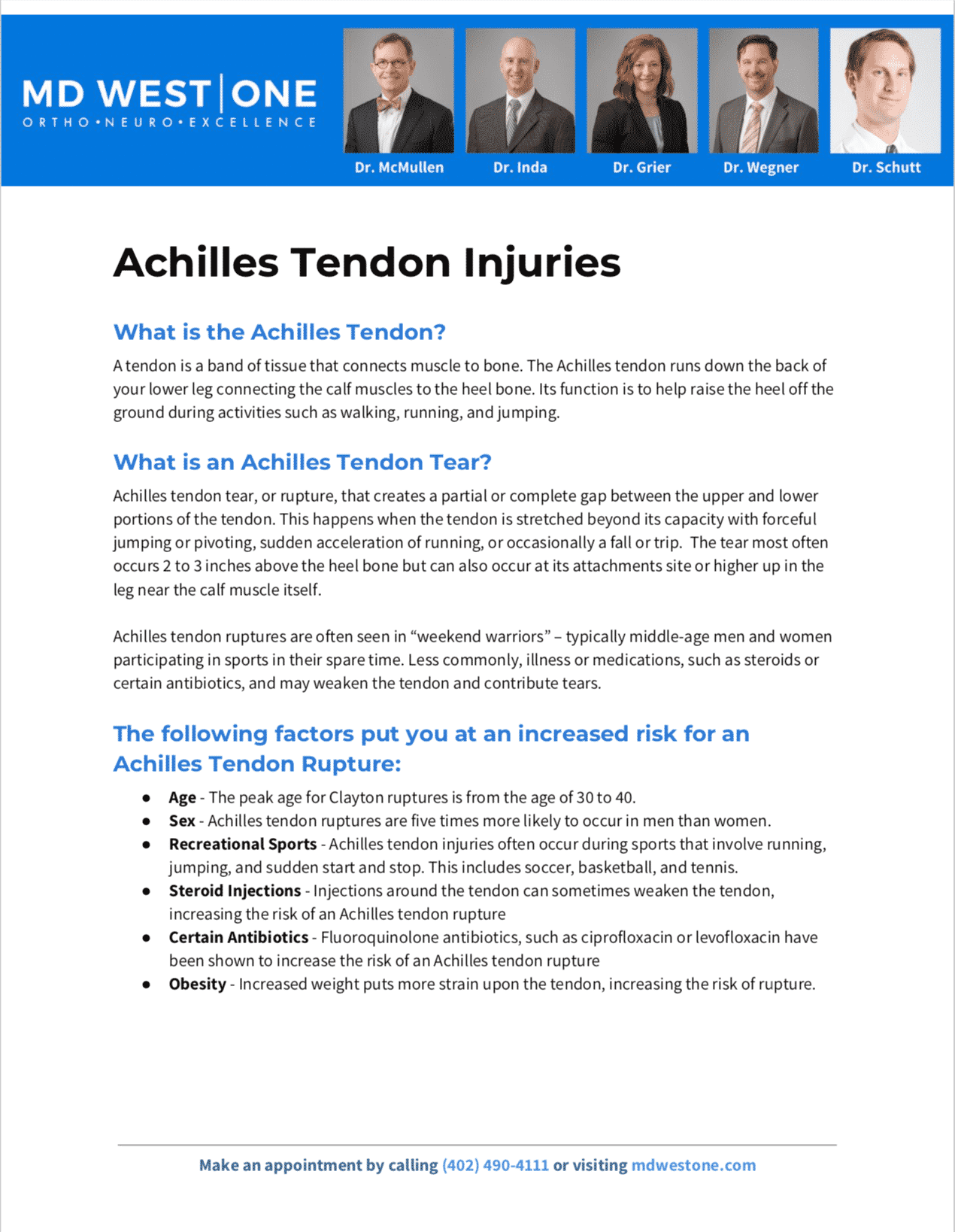Are you suffering from a potential ankle instability injury?
The Omaha Foot & Ankle Specialists at MD West ONE are able to properly diagnose and treat ankle instability injuries through both surgical and non-surgical treatments. If you have the following symptoms, you may want to make an appointment with one of our Board Certified Specialists.
- Ankles feel weak
- Ankles turn in or "give way" unexpectedly
- Pain
- Swelling
Meet MD West ONE's foot and ankle specialists and learn more about how they treat ankle instability injury.
Ankle Instability Causes, Treatments & Surgery
What causes Ankle Instability?
Most often, an improperly healed ankle sprain is the cause of ankle instability. When you sprain your ankle, your ligaments are stretched or torn, and if they are not repaired propery, your ankles will no longer support your weight. If you have experienced multiple sprains, this can worsen your condition.
Surgery for Ankle Instability
Surgery is available for ankle correction, but is not the first treatment method doctors use. In the case of ankle instability, there are a number of nonsurgical treatments you can try first. These include ankle-wraps, anti-inflammatory medications, or an ankle brace. If surgery is necessary for a torn or damaged ligament, you can rest easy knowing you are in the hands of our experienced ankle surgeons.
Treatments options for Ankle Instability
The best way to know the right treatment for your ankle problem is to visit our office for a consultation with one of our expert podiatrists. We can evaluate the extent of the damage to your ligaments and provide a custom treatment plan for you unique condition. Call us today to schedule an appointment with our office and get back on your feet.
The following factors put you at an increased risk for Ankle Instability:
-
Poor Atheltic Conditioning - Anyone who attempts strenuous athletic activities without prior conditioning, such as a regular routine of ankle and calf stretching and strengthening exercises.
-
Muscle and Ligament Fatigue - When muscles and ligaments become fatigued at or near the end of a vigorous activity, people run a higher risk of injury if they "push through" the fatigue in pursuit of more activity instead of resting.
-
Not Warming Up Before Activity - Athletes who go right into vigorous activity without doing a gradual warmup session beforehand, such as gentle stretching and walking before starting a sprint, run a higher risk of injury. Without a warmup period, muscles and ligaments will remain tight, and less flexibility means greater risk for injury.
-
Carrying Excess Weight - Excess weight places greater impact load onto the joints when walking, running, and jumping, which can increase the likelihood that ligaments and/or muscles will be stretched or torn during activity. Some studies indicate that the risk of injury is slightly higher for overweight males than for overweight females.
-
Inappropriate Footwear - Not wearing supportive footwear that is designed for the specific type of playing or walking surface being used can increase risk for developing an injury. For example, wearing high-heeled shoes while walking on an uneven or icy surface, or wearing low-topped shoes instead of high-tops when playing basketball.
-
Prior History of Injury - Persons who have had injury in the past have a higher risk of undergoing the same injury again than persons who have never had an injury.
Ways to Decrease Your Risk of Developing Ankle Instability:
- Warm Up Prior to Any Sports Activity - Lightly stretch or better yet, do a slow jog for two to three minutes to warm up the muscles. Do not force the stretch with a "bouncing motion."
- Condition Your Muscles for The Sport - The amount of time spent on the activity should be increased gradually over a period of weeks to build both muscle strength and mobility. Cross training by participating in different activities can help build the muscles.
- Choose Athletic Shoes Specifically for Your Foot Type - People whose feet pronate or who have low arches should choose shoes that provide support in both the front of the shoe and under the arch. The heel and heel counter (back of the shoe) should be very stable. Those with a stiffer foot or high arches should choose shoes with more cushion and a softer platform. Use sport-specific shoes. Cross training shoes are an overall good choice; however, it is best to use shoes designed for the sport.
- Replace Athletic Shoes when The Tread Wears Out or The Heels Wear Down - People who run regularly should replace shoes every six months, more frequestly if an avid runner.
- Avoid Running or Stepping on Uneven Surfaces - Try to be careful on rocky terrain or hills with loose gravel. Holes, tree stumps, and roots are problems if you are trail running. If you have problems with the lower legs, a dirt road is softer than asphalt, which is softer than concrete. Try to pick a good surface if possible. However, if you are racing, be sure to train on the surface you will eventually run on.
- Be Careful Running Too Many Hills - Running uphill is a great workout, but make sure you gradually build this up to avoid injuries. Be careful when running downhill too fast, which can often lead to more injuries than running uphills!
- Prevent Recurrent Injuries - Athletes who have experienced ankle injuries previously may benefit from using a brace or tape to prevent recurrent ankle injuries.
- Listen to Your Body - If you experience foot and ankle pain during a sport, stop the activity or modify the activity until the pain subsides. Also, if you have been injured, you should go through a period of rehabilitation and training before returning to the sport to prevent recurrent injuries.
DIAGNOSIS
To diagnose ankle instability, the first step is to determine whether or not the injury demands emergency care. There is an increased likelihood that the ankle injury is accompanied by a fracture if the person experiences pain in the malleolar or midfoot region and meets at least one of the two criterea:
- Bony tenderness on palpation of the posterior edge of the distal 6 cm of the tibia or fibula, or tenderness on the medial or lateral malleolus.
- Inability to bear any weight on the affected foot immediately after the injury and for four steps into the emergency department.
NON-SURGICAL TREATMENT OPTIONS
Once we diagnose your ankle instability condition, we will prescribe the most appropriate treatment to heal or improve your condition. We typically recommend one or more of these approaches:
- Ice packing and rest help the healing of some simple ankle sprains and strains and other injuries.
- Foot taping or padding can protect the affected area, such as heel pain.
- Physical therapy (PT) focuses on reducing pain by strengthening feet and ankles through exercise. PT also helps with arthritis and ankle instability, especially following an orthopedic surgical procedure.
- Splinting, bracing, or casting provide support for sprains, strains, fractures of the ankle or foot, and other injuries.
SURGICAL TREATMENT OPTIONS
Your orthopedic surgeon may determine that your condition will respond most effectively to a surgical procedure. Whenever possible, your orthopedist will use minimally invasive arthroscopy either to examine your condition with a tiny camera, or to repair the damaged tissue. When surgery is your best option, our surgeons perfrom the most advanced surgical procedures, including:
- Arthroscopic surgery
- Fracture management to relieve pain, prevent further injury, and remove any tissue that is injured and causing pain
- Nerve release/reconstruction to relieve pressure on the nerve
- Tendon release/reconstruction to decrease tension on the tendon and allow the muscle to move freely
- Total ankle replacement
Frequently Asked Questions?
What is the recovery time for treating ankle instability with surgery?
After this type of surgery, you will be placed in a splint for 2-3 weeks. At that time, we will take the stitches out and give you a boot. You will begin to move the ankle joint up and down on your own. You will not be able to put weight onto the ankle for a total of 4 weeks. You will remain in the boot for about 8 weeks after surgery and will continue to increase your activity at that point.
Is physical therapy necessary after surgery?
Yes. Physical therapy is necessary after surgery to regain motion of the ankle, strengthen the ankle, break up scar tissue, and decrease swelling. A physical therapist will also help you with your gait and balance. This is typically started 4 weeks after the procedure and is continued until your goals are met.
AMERICAN ORTHOPAEDIC FOOT & ANKLE SOCIETY
All of the foot and ankle surgeons in the practice are recognized members of the American Orthopaedic Foot & Ankle Society. It is the oldest and most prestigious medical society dedicated to the foot and ankle. The mission of the society is to advance science and practice of foot and ankle surgery through education, research, and advocacy on behalf of patients and practitioners. These physicians dedicate their time and energy to improving the patient experience and their knowledge in their field. For more information visit http://www.aofas.org.
MD West ONE Foot & Ankle Specialists:
The Foot & Ankle Specialists are all Board Certified and Fellowship-Trained, meaning they’ve focused their education, training and research on orthopaedic surgery of the foot and ankle.






